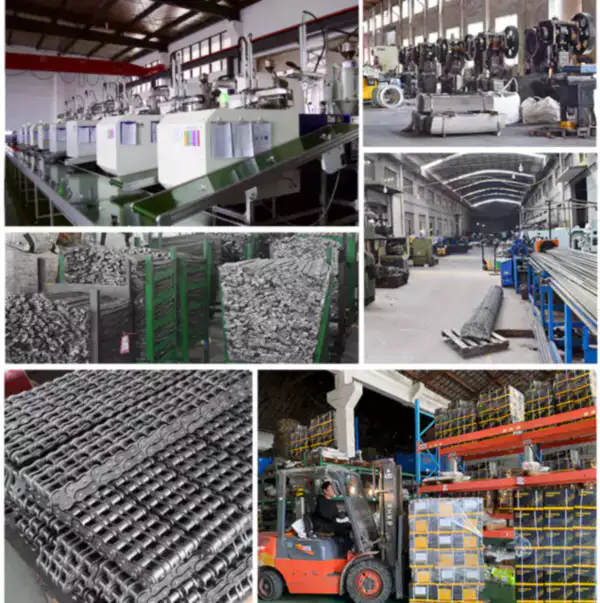Introduction
Gripper chains are an essential component in various industries, providing reliable and efficient gripping solutions. To ensure their longevity and optimal performance, it is crucial to store spare gripper chains properly. In this article, we will delve into the best practices for storing spare gripper chains, highlighting key considerations and methods.
1. Temperature and Humidity Control
Proper storage conditions play a vital role in preserving the quality and functionality of spare gripper chains. Maintaining a controlled environment with optimal temperature and humidity levels is essential. Exposure to extreme temperatures and high humidity can lead to corrosion and degradation of the chains, reducing their lifespan.

2. Clean and Dry Storage Area
When storing spare gripper chains, it is imperative to keep the storage area clean and dry. Any debris or moisture can accelerate the chain's deterioration. Regular cleaning and inspection of the storage area will prevent the accumulation of dirt, dust, and other contaminants, ensuring the chains remain in pristine condition.
3. Proper Packaging and Wrapping
To protect spare gripper chains from external elements and potential damage, it is recommended to package and wrap them appropriately. Using anti-corrosive materials such as plastic or oil-coated paper can provide an additional layer of protection against moisture and oxidation. Securely sealing the packaging will prevent any contaminants from entering and affecting the chains.

4. Vertical Storage Orientation
Storing spare gripper chains in a vertical position is a recommended practice. This method helps prevent excessive stress and strain on the chains, minimizing the risk of tangling or entanglement. Vertical storage also enables easy access and identification of specific chain types or sizes, facilitating efficient inventory management.
5. Regular Inspection and Maintenance
Periodic inspection and maintenance are essential for stored gripper chains, even if they are not currently in use. Regularly checking for signs of corrosion, wear, or any other damage will allow for timely repairs or replacements. Lubrication and proper cleaning should also be performed to ensure the chains remain in optimal condition.
6. Labeling and Documentation
An organized storage system for spare gripper chains involves proper labeling and documentation. Clearly labeling each chain with relevant information such as size, type, and date of storage will aid in easy identification and retrieval. Additionally, maintaining detailed documentation of the stored chains will streamline inventory management and help plan future procurement.

Purchasing Guide for Gripper Chains
| Feature | Consideration |
|---|---|
| Chain Material | Choose high-quality materials resistant to corrosion and wear. |
| Chain Size and Strength | Select the appropriate chain size and strength based on the application requirements. |
| Chain Configuration | Consider the specific gripping needs and opt for the suitable chain configuration. |
| Manufacturer Reputation | Research and choose a reputable manufacturer known for producing reliable gripper chains. |
| Price and Warranty | Compare prices and warranties to ensure a cost-effective and reliable purchase. |
Sprockets for Gripper Chains
Gripper chains and sprockets are interdependent components, working together to ensure smooth operation and efficient gripping performance. Sprockets provide the necessary rotational movement and alignment for gripper chains, making them indispensable in various applications. Our company offers a range of sprockets specifically designed to complement gripper chains, ensuring optimal compatibility and performance.

As a leading chain manufacturer, we hold several advantages that set us apart:
- Extensive industry experience: With years of experience, we have gained in-depth knowledge and expertise in producing high-quality gripper chains.
- Advanced manufacturing facilities: Our state-of-the-art manufacturing facilities enable us to ensure precision and consistency in every chain we produce.
- Strict quality control measures: We adhere to rigorous quality control standards throughout the manufacturing process, guaranteeing superior products.
- Customization options: We offer customization services to meet specific customer requirements, providing tailored solutions for various applications.
- Reliable customer support: Our dedicated customer support team is committed to providing prompt assistance and addressing any queries or concerns.

Q&A on Gripper Chains
Q: How often should I inspect my gripper chains?
A: Regular inspection is recommended, depending on the frequency of use and operating conditions. Monthly or quarterly inspections are common practice, but more frequent inspections may be necessary in demanding environments.
Q: Can gripper chains be repaired if damaged?
A: Minor damages can often be repaired by replacing specific chain links or components. However, significant damage may require complete chain replacement to ensure safety and optimal performance.
Q: Are gripper chains suitable for high-speed applications?
A: Gripper chains are designed to withstand various operating speeds. However, it is essential to select the appropriate chain type and ensure proper lubrication and maintenance to achieve optimal performance in high-speed applications.
Edited by Zqq.
